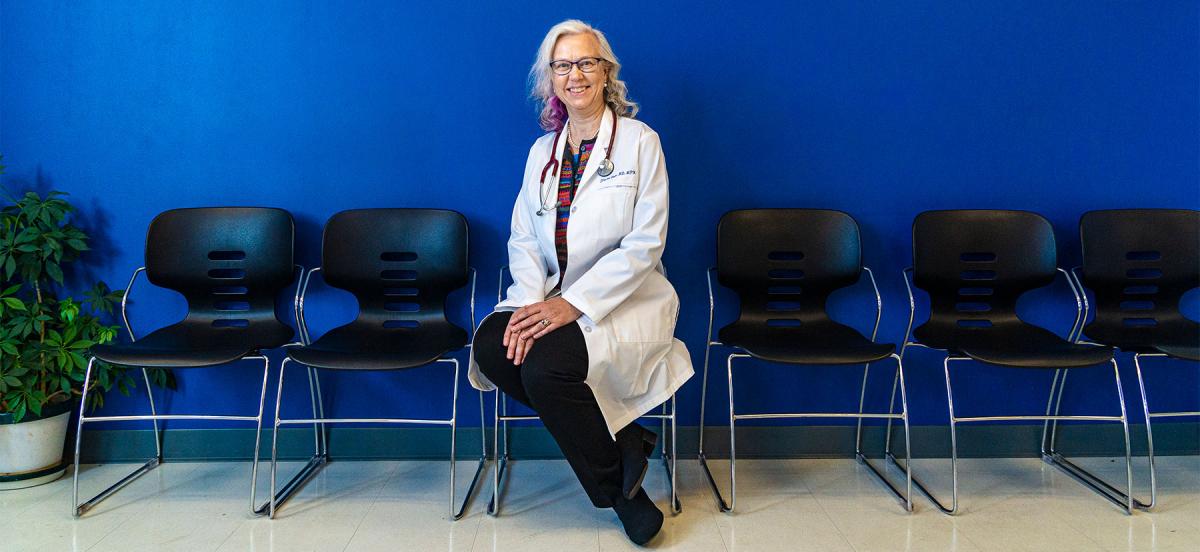Understanding the Opioid Crisis

Dr. Yngvild Olsen '91 is one of the authors of the new book, The Opiod Epidemic: What Everyone Needs to Know. Photo by Patrick Montero.
Details
Yngvild Olsen ’91, a physician specializing in addiction medicine, has recently published a book meant to “clarify and demystify” the national health emergency.
As a physician specializing in addiction medicine, Yngvild Olsen ’91 has been on the front lines of the nation’s opioid crisis for two decades. She’s seen darkness, despair, and death.
Yet when she speaks about her work, she talks about the patients who keep fighting in spite of unbelievable challenges—from society, the government, even their families and friends. The misperceptions about people with addictions is one of the greatest barriers to successfully dealing with the problem, she says.
That’s one reason she co-authored The Opioid Epidemic: What Everyone Needs to Know with her husband, Joshua M. Sharfstein, a professor at the Bloomberg School of Public Health.
Published by Oxford University Press, the book is meant to “clarify and demystify” this national health emergency by detailing its beginnings, explaining why the societal stigma surrounding addiction is unfair, and offering public health solutions that can help.
Olsen, who earned her M.D. from Harvard Medical School and has a master’s in public health from the Johns Hopkins Bloomberg School of Public Health, is the medical director for the Institutes for Behavior Resources, Inc./REACH Health Services, a comprehensive addiction treatment center in Baltimore. She’s also current vice president of the American Society of Addiction Medicine.
How did you choose your specialty?
Addiction medicine combines so many different aspects (of medicine) that I find interesting and that I’m incredibly passionate about, including medicine broadly, internal medicine, psychiatry, neurology, neurobiology, and basic science research. It includes social justice, law, and public policy.
What is the biggest misperception about people with an opioid addiction?
That people have done it to themselves and that it’s their own fault. Addiction is not a moral failing. It’s a chronic brain disease with multiple risk factors including family history (genetics), early childhood trauma, the presence of other mental health conditions, and exposure to substances like cigarettes, alcohol, or marijuana before age 14. It is treatable. We have effective treatments. There’s stigma against people with opioid-use disorder. But if we present the facts and the science, we can end that stigma and move from punitive criminal justice solutions to public health and health solutions.
When did you see the first signs of a crisis?
There’s essentially been three waves. The first, around 2000, was related to the significant increase in physicians prescribing opioids for pain. Drug companies aggressively marketed these medications and told physicians that the risk of addiction from prescription opioids was negligible. There was very little education in medical school or during residency about safe prescribing and addiction, meaning physicians didn’t recognize when patients were developing a problem. When physicians realized their patients had developed addictions, they essentially said, “I can’t provide this anymore” and stopped writing prescriptions. So, the patient with an addiction turned to street sources of opioids, often heroin. Increases in heroin use and related overdoses have been the second wave. Fentanyl is causing the third wave that’s been so dramatic and acute. Fentanyl is 50 to 100 times more potent than heroin. You only need a tiny amount to cause an overdose death. Even people with long histories of using heroin can’t tolerate it.
What are some of the public health solutions IBR/REACH Health Services employs?
Comprehensive treatment includes medication, counseling, peer support, and treatment of other medical issues including mental health conditions. Case managers help patients get health insurance and provide help if they need transportation. Medications like methadone and buprenorphine, which we offer at the clinic, have, in study after study over the past 50 years, been shown to decrease mortality from opioid-related overdose by 50 to 75 percent. But methadone is only available at highly regulated clinics. Buprenorphine is only available by prescription from a doctor who has a federal government waiver. About five percent of U.S. doctors have it.
Your book’s cover features a collage of doors of different colors, materials, sizes, and shapes. What were you trying to suggest with that?
Addiction does not discriminate and can happen to anyone. It can be behind every door. People with addiction also face a lot of doors, particularly closed doors. There should be no wrong door to getting help.
Could you share a few of your patients’ stories?
A patient came to the clinic five years ago with opioid and cocaine addictions. She was homeless, unemployed, and had no hope for the future. She got a lot of support from our clinical team, including counseling, therapy, and medications. Then her brother died. I thought she was going to go off the rails. I thought we would lose her. Instead, she reconnected with her family and moved in with an aunt. She got a job, then a promotion. She discovered a love of the outdoors and being physically active. She began volunteering at an animal shelter. People surprise you again and again. People who have an addiction are so resilient, they’re survivors. With the right kind of nonjudgmental support, they can turn their lives around. That, for me, is what keeps me waking up every day. There’s so much hope.



